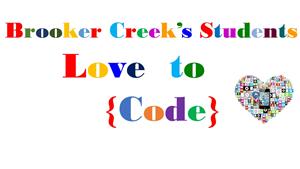Brooker Creek’s Virtual Computer Club
-
Brooker Creek’s Computer Club is now Virtual and students will now self-enroll and complete lessons from home at their own pace. This club will utilize the SCRATCH visual programing language within a secure classroom-friendly program created by CODE.ORG. Students will learn to create their own interactive stories, animations, games, music, and art using this program.
Creative computing is about creativity. Creative computing supports the development of personal connections to computing, by drawing upon creativity, imagination, and interests.
Creative computing is about computing. Many students with access to computers participate as consumers, rather than designers or creators. Creative computing emphasizes the knowledge and practices that students need to create the types of dynamic and interactive computational media that they enjoy in their daily lives.
Engaging in the creation of computational artifacts prepares students for more than careers as computer scientists or as programmers. It supports young people’s development as computational thinkers – individuals who can draw on computational concepts, practices, and perspectives in all aspects of their lives, across disciplines and contexts.
Students enrolled in this club will learn how to:

- Use the basic steps in algorithmic problem-solving to design solutions (e.g., problem statement and exploration, examination of sample instances, design, implementing a solution, testing, and evaluation).
- Define an algorithm as a sequence of instructions that can be processed by a computer.
- Use predefined functions and parameters, classes and methods to divide a complex problem into simpler parts.
- Describe a software development process used to solve software problems (e.g., design, coding, testing, verification).
- Collaboratively design, develop, publish, and present products (e.g., videos, podcasts, websites) using technology resources that demonstrate and communicate curriculum concepts.
- Collaborate with peers, experts, and others using collaborative practices such as pair programming, working in project teams, and participating in group active learning activities.
- Evaluate programs written by others for readability and usability.
- Recognize that computers are devices that execute programs.

